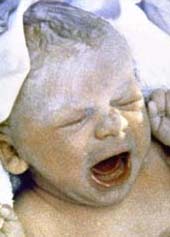IVF

Louise Joy Brown -- born on this day in 1978, the daughter of Gilbert and Lesley Brown -- was the most famous newborn of her time, due to the uniqueness of her conception. Her parents were childless for 9 years due to a blockage in Lesley Brown's fallopian tubes which prevented eggs from reaching her womb. Dr. Patrick Steptoe of Oldham, England, and Dr. Robert G. Edwards of Cambridge sought to remedy this by operating to remove an egg from Mrs. Brown and combining it with sperm from Mr. Brown in a culture dish. After 2-1/2 days, when in Edwards' words, "she was a beautiful eight cell embryo," the future Louise Brown was implanted in Mrs. Brown's womb.
37 weeks later, Mrs. Brown gave birth to a normal, healthy 5-lb., 12-ounce Louise by cesarean section. Although the procedure had been tried numerous times before, it had never been successful. At least initially doctors credited the early return of the embryo to the womb as a key factor in making the in vitro fertilization (IVF) procedure work, as well as the doctors' attention to the delicate matter of convincing the mother's system to receive the implantation.
By 1998, there had been 29,000 babies born with the assistance of in vitro fertilization in the United Kingdom, including Louise’s younger sister Natalie, and tens of thousands worldwide. On her 20th birthday, Louise delivered a message to the public, stating "I’m glad mum and dad were given the opportunity of having IVF 20 years ago. I wish this was available to all who need it now."





0 Comments:
Post a Comment
Subscribe to Post Comments [Atom]
<< Home